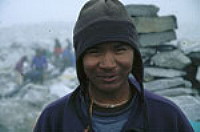
Photo. One of the Sherpas.
© ExplorersWeb.
As the world famous expedition guide ExplorersWeb writes on its website (www.ExplorersWeb.com): “It’s also about daring to dream and acting on it. No matter who you are, at what point in your life, weak, poor or afraid. Everest is our highest mountain and the climb has an everlasting, profound impact on most Everest climbers life. True, some die, yet far more survive to a whole new vision on life.”
When people reach the top of the world tallest montain, they become world famous. But it`s easy to forget that it someone stand behind them, the Sherpas. How could these people reach the top without assistence from the Sherpas?
Be aware of that a sherpa is not necessarily a member of the Sherpa ethnic group. Sherpa generally act as porters on Everest expeditions.
The most famous Sherpa is Tenzing Norgay, who climbed Mount Everest with Edmund Hillary for the first time in 1953. Tenzing's son Jamling Tenzing Norgay, also climbed Everest in honor of his father with the famous Ed Viesturs during the disastrous year of 1996. Why are the Sherpas such fantastic climbers? ExplorersWeb has written an article about the Sherpa who tells a lot about these people and also give climbers useful advise.
The Sherpas
(based on an articles from Explorersweb (www.ExplorersWeb.com):
Lakhpa, Dorjee, Tensing, Nawang, Tashi - you will soon get familiar with these common sherpa names. Often they simply mean the days of the week: Monday, Tuesday, Wednesday and so on. The guys are conveniently enough named by the day of the week when they were born!
Sherpas are the inhabitants of the Khumbu-valley, the national park surrounding Everest. Khumbu is located in northeastern Nepal and includes the town of Namche Bazaar as well as the villages of Thami, Khumjung, Pangboche, Pheriche and Kunde.
Living at altitude for generations, they have developed a genetic natural allowance for it. If you are well trained yourself, you might find in Kathmandu that the Sherpas do substantially fewer push-ups than you do. Don’t get too excited. Once you go above 3000 meters/10000 ft most of them will easily outrun you. Their natural advantage is strongest up to 8000-meters/23000 ft, there after they too will face problems. Most sherpas will consequently require oxygen above camp 4 in order to perform at their best.
The sherpas are usually happy and easy going. They take great pride in their mountaineering heritage, just as another famous people of Nepal, the Gurkhas, who take pride in their warrior skills.
Since Sherpas are stronger than us at altitude, they are very well suited for alpine style expeditions in the Himalayas. You will need them to carry the oxygen, the gear and as a safety on the summit push. Many "solo" climbers actually bring sherpas with them all the way up. Sherpas are a valuable aid to us, as the climb will be hard enough for you anyway, in not being genetically adapted to that kind of altitude by birth.
To work with Sherpas will require good management on your part and to find the good people to begin with. The trekking agency will recommend Sherpas connected to them. Check if the Sherpa has made the summit and when so (we asked for and were assigned 2 summit Sherpas once, but it was never made clear that they last summited in 1978 and 1982).
It’s also wise to check if the Sherpa is motivated to go for the summit again. Young non-summiteers could be hungry to summit, but lack experience. Summiteers might be content with the higher rank and salary that their summit has already entitled them and not really be motivated to summit again.
Talk to other climbers about the sherpas they liked and try to hire those people. Should you still have to work with Sherpas that you are not familiar with - the most common procedure - remember that the more self sufficient and skilled you are, the less dependent will you be on them. In the end though, if the weather is good and they trust your abilities, they will usually go for the summit, or close enough, with you.
Remember a simple fact: you get what you pay for. Sherpas that are known to perform well (this meaning being responsible and hard working) will require higher salaries than their counterparts.
As you should be careful to save money on the wrong things, you might think this over before you end up with people turning on you when you need them most.
Again, have specified on paper with the trekking agency what you will ask from your staff. Meet with the sherpas in Kathmandu about the very same thing, so that you are all clear on what’s expected. Still though, don’t get surprised if what’s agreed on in Kathmandu will turn different once on the mountain. It comes with the neighborhood and you will simply have to deal with it there and then.
Finally, remember; the sherpas are not your servants. Use them for the important tasks. They speak broken English and are usually not so schooled, but they can think very well for themselves. They will need respect. And - as any staff - motivation along with clear leadership.
Have meetings about the gear, climbing decisions and problem solving. Make sure that you at all times know what’s going on in the expedition; which tents are to be used and where, exactly how much fuel, food and gear is at each camp.
Check the oxygen, regulators and masks together beforehand. Mark everything with each person's name and so on. Don’t leave it all to your Sirdar (Sherpa leader): You are the expedition leader! Only then will you get respect and your decisions will be trusted.
Written by ExplorersWeb - www.ExplorersWeb.com
- Some parts of this article is edited and supplied with information by Stein Morten Lund, Travel Explorations, 10 May 2008
Additional information
Presentation of ExplorersWeb:
The website ExplorersWeb - www.ExplorersWeb.com - is aimed to open up the most extreme parts of the world to all go-wishers. The site publishes independent, non-commercial guides and news on mountaineering, ocean sailing, polar treks and other upcoming fields. Explorers with own, first hand experience operates the site.
Information about the Sherpas:
(source: Wikipedia - www.Wikipedia.com):
The Sherpa (Tibetan:"eastern people", from shar "east" + pa "people") are an ethnic group from the most mountainous region of Nepal, high in the Himalayas. Sherpas migrated from eastern Tibet to Nepal within the last 500 years. A sherpa woman is known as a "sherpani".
The term 'sherpa' is also used to refer to local people, typically men, who are employed as guides for mountaineering expeditions in the Himalayas, particularly Mt. Everest. Sherpas' high altitude adaptations arise at the molecular level. Some of these adaptations include: unique hemoglobin-binding enzymes; doubled nitric oxide production, hearts that can utilize glucose, and lungs with an increased sensitivity to low oxygen. It has also been suggested that one reason why they were widely used as porters is that they had fewer dietary prohibitions than most people of the region and were prepared to eat whatever was available to them on expeditions.
Most Sherpas live in the eastern regions; however, some live farther west in the Rolwaling valley and in the Helambu region north of Kathmandu. Pangboche is the Sherpas' oldest village in Nepal. Sherpas speak their own Sherpa language which in many ways resembles a dialect of Tibetan.
More information about the Sherpas:
Read the article Sherpas of Mount Everest on National Geographic: Sherpas - National Geographic












